Situated at the foot of Mt. Bukhan on the northern edge of Seoul, Jinkwan Temple is famed as the home of authentic Korean temple cuisine. The culinary tradition is now carried on by the Venerable Gyeho, abbess of the temple, where royal ceremonies of the Joseon court were held hundreds of years ago.
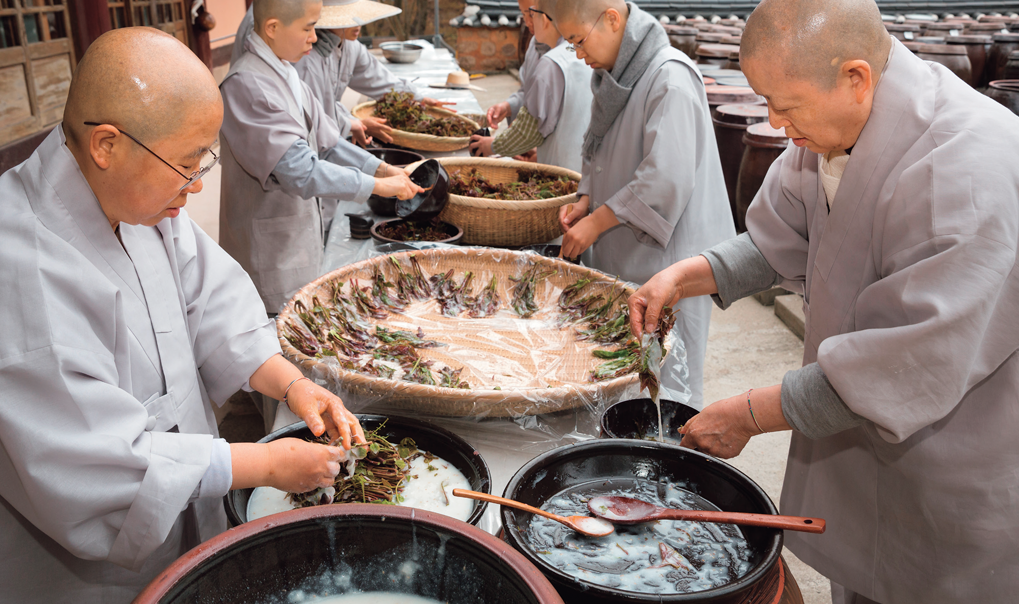
Venerable Gyeho (far right), the abbess, and other nuns of Jinkwan Temple cover Chinese toon shoots with rice paste to make deep-fried chips. It is a collaborative job that has to be done quickly on a sunny day.
On April 19, the mountain trail leading to Jinkwan Temple was fragrant with wildflowers giving off the sweet scent of spring. Under the jurisdiction of Jogye Temple, the headquarters of the First Diocese of the Korean Buddhist Jogye Order, Jin-kwan Temple was established over a thousand years ago. Even during the Confucian-oriented Joseon Dynasty, when Buddhism was suppressed, the temple was frequently visited by the kings.
King Taejo (r. 1392–1398), the founder of Joseon, installed a state agency within the temple to carry out Suryukjae, or the Rite for Deliverance of Creatures of Water and Land. Dedicated to lonely spirits and hungry ghosts roaming this world after death, the rite was intended to console their souls with a feast of food and the teachings of the Buddha. Taejo used this rite to pray for the countless souls of those who had died in the process of establishing Joseon.
Jinkwan Temple was almost entirely destroyed by fire during the Korean War. In 1963, the Venerable Jinkwan (1928–2016), a respected leader of nuns, set out to reconstruct the temple, which eventually earned the distinction of being a leading monastery for bhikkhuni, or ordained female monastics. Serving as its abbess for over 40 years, the Venerable Jinkwan preserved and modernized the culinary tradition of the Suryukjae, and her temple food recipes have been handed down to her successor, the Venerable Gyeho.

The toon shoots and leaves coated with rice paste are spread out on a wicker tray and left to dry on the sunny and breezy crock terrace. After sunset, they are placed in a warm room with floor heating to be further dried.
Authentic Temple Cuisine
Bright spring sunlight shone on the windowsill of the cooking studio in the Temple Food Institute at Jinkwan Temple, and what seemed like the sound of a wooden temple block attracted visitors to the hall. The sound, however, came not from a moktak but the knife in the hand of the Venerable Gyeho, cutting a radish on a table almost seven to eight meters long.
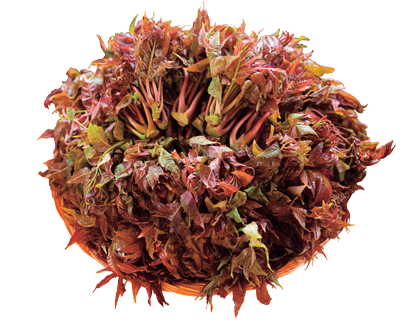
In early spring, Chinese toons grow purplish green shoots (above). At Korean Buddhist temples, they are eaten fresh, seasoned with simple condiments, or preserved by making chips or pickling them in soy sauce. When the shoots are mixed into a batter of flour, salt and water with red pepper slices, and fried on a pan, their unique aroma is intensified (below).
After a few minutes, the radish, originally in the shape of a short club, was cut into a curious-lookingresembling a stamp with a handle. The Venerable Gyeho called it the “oily radish hand.” Dipping the radish in sesame oil and then rubbing it on the frypan is an efficient way of applying oil, a trick she learned from her mother as a child. The abbess, now going on 70, was born in Mukho (today’s Donghae) along the east coast in Gangwon Province. Her mother and maternal grandmother were both devout Buddhists and excellent cooks. In her childhood, she would hover around the kitchen and watch her mother cook staples like soybean paste stew (doenjang jjigae) and stuffed buckwheat crepes (memil jeonbyeong). The young girl was praised whenever she cooked herself with skills learned by observing her mother.
She was attracted to Buddhism as a high school student, when she felt her heart beating hard as she listened to a sermon by the Venerable Tanheo (1913–1983). The preeminent monk, who had devoted himself to the translation of the Tripitaka Koreana, the 13th-century Buddhist canon carved on some 80,000 woodblocks, was renowned for his extensive knowledge of Eastern philosophy. Although her family tried to stop her, the 18-year-old girl left secular life behind and joined the monastic order at Jinkwan Temple in 1968. Her teacher, the Venerable Jinkwan, was her guiding light in her spiritual practice.
“The sun is shining now. Shall we go out?” asked the abbess.
No sooner was it said than the several devotees in the cooking studio followed her out to the courtyard. In front of the crock terrace, where hundreds of big pottery jars holding traditional sauces and pastes were placed in neat rows, was a long table covered with a plastic tablecloth, much like that in the film “Babette’s Feast.” On the table were a few wicker trays about two meters in diameter and bowls of rice paste made from a mixture of regular and sticky rice. Ten or so nuns, including some fairly young ones, came out to make deep-fried chips (bugak) with the young shoots and leaves of red toon (Toona sinensis).
Essential Side Dish and Snack
Standing on either side of the table, the nuns began to cover the shoots with rice paste, following the instructions of their abbess. Tinged with light brown, red toon shoots are in season in March and April. From old times, red toon shoots have been widely consumed at Buddhist temples. Prepared in spring to be fried and eaten all year round until the end of winter, it was the monks’ favorite snack and side dish. The deep-fried chips made with dried vegetables or seaweed coated with rice paste are a quintessential temple food.
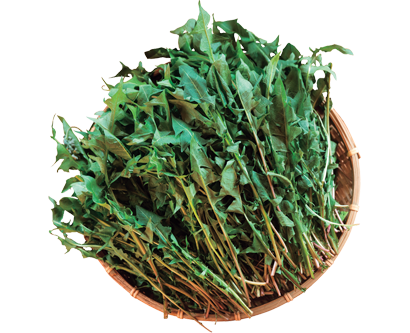
Readily available in spring, dandelion leaves tossed with soy sauce, plum seed extract, bamboo salt, sesame oil and roasted and salted sesame seeds make a sweet and sour salad with crunchy texture (above). Dandelions are known to refocus vital energy and be effective in relieving inflammation (below).
“The act of eating is concerned with life, harmony, virtue and compassion. What you eat forms your body and personality,” the abbess said. Her toon shoot chips are well-known inside and outside Korea, and this fame is partly owing to the American actor Richard Gere, who was especially taken with this food when he visited the temple and had a meal prepared by the abbess.
Recipes with No Excess
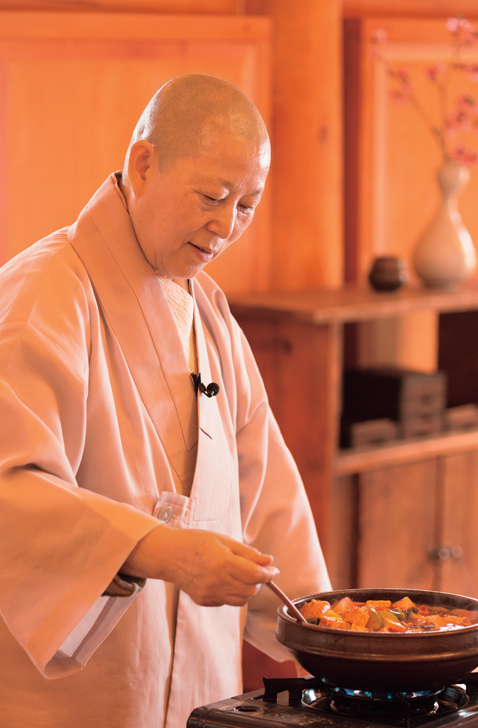
Venerable Gyeho cooks vegetable stew with soybean paste fermented at her temple for five years. She inherited the authentic temple food recipes from her teacher, the late Venerable Jinkwan, who had preserved and modernized the culinary tradition of temple rites.
The Venerable Gyeho’s recipes are simple but have a rich, deep flavor. Perhaps it was to learn the secret of this flavor that famous chefs from other countries have come to the temple to meet her. Among them were Sam Kass, the former White House chef who served as President Obama’s senior policy advisor for nutrition policy, as well as the famous French chef Éric Ripert. Last March, Queen Mathilde of Belgium also visited her and discussed the importance of children’s mental health and a healthy diet. Asked about her meetings with these foreign visitors, the abbess answered, “Whether from the East or the West, cooks with wellness in mind have similar views on food: they search for natural flavor. I stay in touch with Sam Kass, who also likes a healthy flavor.” This is consistent with the rise of veganism in America and Europe, and it may well be that Korean temple food plays a role in this trend.
Temple food features as many different vegetable dishes as there are plants in the mountains. The shoots sprouting on the branches of castor aralia (Kalopanax pictus) are a spring delicacy for monks and nuns. The Venerable Gyeho counts them among the three best spring vegetables, along with the shoots of the Korean angelica tree (Aralia elata) and mugwort. Called gaedureup in Korean, angelica tree shoots are especially good for treating stomach troubles as they aid digestion and stimulate the appetite. Rich in iron and amino acids, they also help to keep knee joints healthy.
Aside from fresh ingredients, it takes proper seasoning to cook a tasty dish. The abbess uses only three kinds of condiments: soy sauce fermented for three to five years, sesame oil, and toasted and ground sesame seeds mixed with salt. Her recipe is also very simple.
The shoots are simply cleaned, parboiled, and then seasoned with the three condiments. Simple recipes make a simple life, she said, whereas food cooked with elaborate and extravagant recipes complicates life. It is also an act of self-discipline to keep seasoning to a minimum because it amounts to giving up the desire to make it more delicious.
It is also an act of self-discipline to keep seasoning to a minimum because it amounts to giving up the desire to make it more delicious.
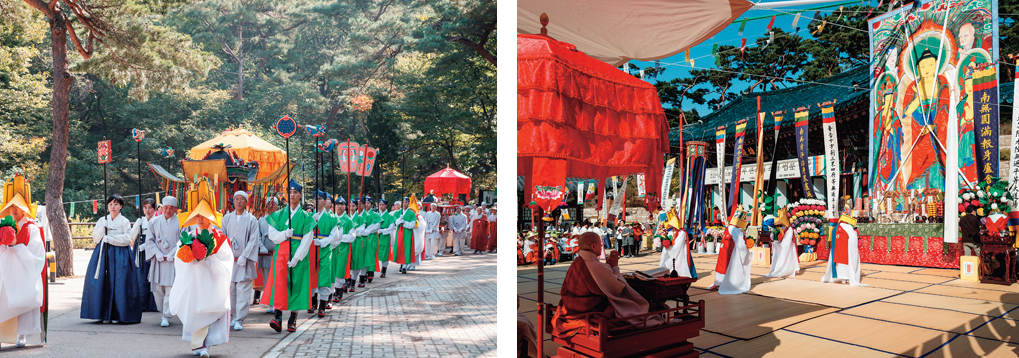
The toon shoots and leaves coated with rice paste are spread out on a wicker tray and left to dry on the sunny and breezy crock terrace. After sunset, they are placed in a warm room with floor heating to be further dried. © Jinkwan Temple
Comfort Food
In life, we sometimes flounder on the sea of pain, hurt by the harsh words of others or frustrated by our own failures. On such occasions, we tend to turn to comfort food to console our broken hearts and give us strength. As a religious practitioner, does the Venerable Gyeho also have such a food? The abbess said she sometimes thinks of the soybean paste stew that her mother would cook for her when she was a child.
“Speaking of which, shall we make the stew?” the abbess asked.
The gathered devotees perked up at her words. Having tasted her dandelion salad, seasoned castor aralia shoots and crispy toon chips, they probably felt the cooking studio was a paradise.
Her soybean paste stew was not as salty as most others and its flavor had an attractive lightness, just like Pyongyang-style naengmyeon (cold buckwheat noodles). The conversation between the abbess and the devotees resembled the dialogue between the Buddha and his disciples.
“What is your favorite food, Venerable?” one of them asked.
“Seungso is rather tasty,” answered the abbess, with a child monk’s innocence and a young girl’s shyness flashing across her face. Meaning literally “a monk’s smile,” the food that makes monks and nuns smile is noodle soup.
Park Mee-hyang Food Culture Reporter, The Hankyoreh
Ahn Hong-beomPhotographer